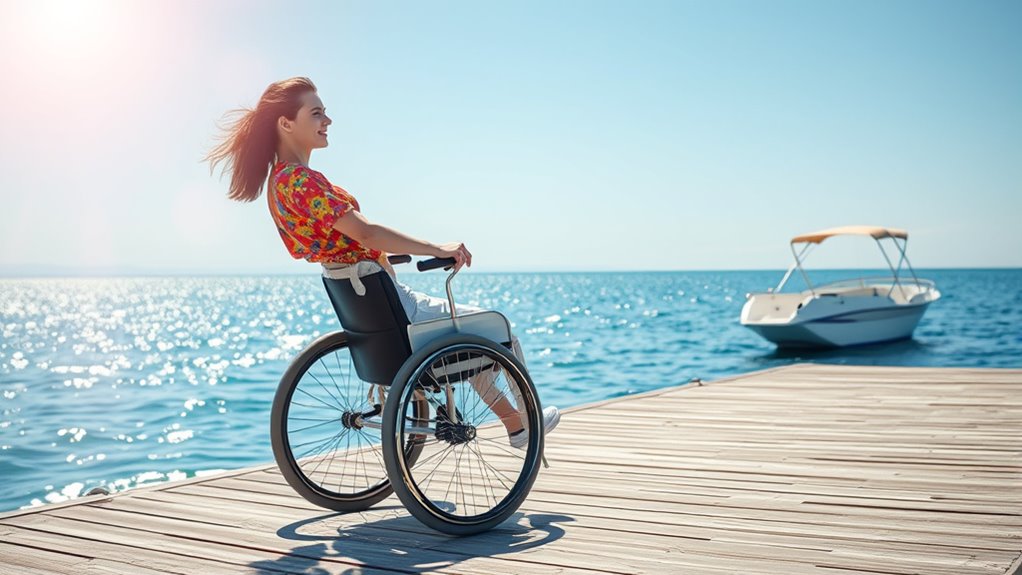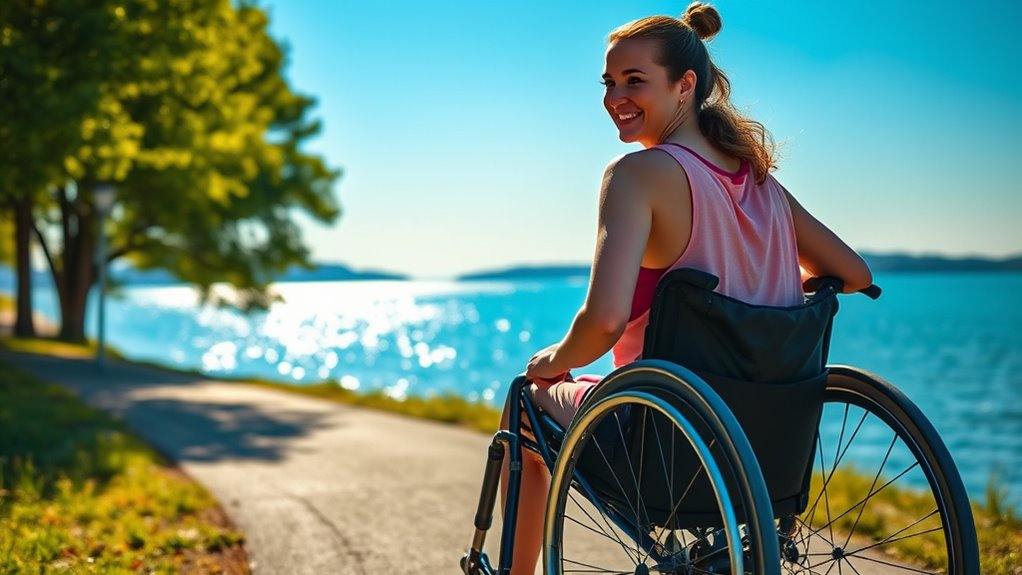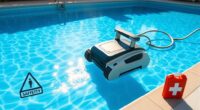Your journey from wheelchair to water begins with choosing to seek help, embracing assistive technology, and building emotional resilience. Water-based therapy offers a calming environment that reduces strain and boosts confidence, while adaptive tools support independence. This holistic approach combines physical recovery with mental strength, opening new possibilities for growth and healing. If you keep exploring, you’ll discover inspiring stories of hope and the transformative power of resilience, recovery, and connection through water.
Key Takeaways
- Deciding to seek help initiates physical and emotional recovery, with assistive technology playing a vital role.
- Emotional resilience helps individuals manage setbacks and stay motivated throughout their rehabilitation journey.
- Water-based activities like aquatic therapy reduce strain, promote relaxation, and support physical improvements.
- A holistic approach combining assistive tools, emotional strength, and new routines fosters a sense of hope.
- Progress symbolizes transformation, empowering individuals to transcend limitations and embrace renewed potential.

When someone decides to seek help, it marks the beginning of a powerful journey toward recovery and renewal. You may feel uncertain or overwhelmed, but this decision shows a deep desire to regain independence and improve your quality of life. As you set out on this path, you’ll discover that assistive technology plays a crucial role in your progress. Devices like powered wheelchairs, adaptive paddles, or waterproof communication tools become extensions of your determination, helping you navigate daily challenges with confidence. These tools are designed not just to assist physically but to empower you emotionally, fostering a sense of control and independence that fuels your resilience.
Throughout your rehab journey, you’ll learn that emotional resilience is just as important as physical recovery. It’s normal to face setbacks or moments of frustration, but resilience helps you adapt and push forward despite obstacles. Your mental strength becomes a cornerstone, allowing you to stay motivated and optimistic even when progress feels slow. Therapists and support groups will encourage you to develop this resilience by celebrating small victories and teaching coping strategies that maintain your mental well-being. As you grow stronger emotionally, you’ll find it easier to embrace new routines and challenges, transforming setbacks into opportunities for growth. Recognizing the importance of physical therapy can help you tailor your recovery to achieve better results and maintain your progress over time.
Building emotional resilience helps you overcome setbacks and embrace growth throughout your recovery journey.
Your rehab experience will involve a combination of physical therapy, emotional support, and innovative assistive technology. As you practice water-based activities, such as aquatic therapy or swimming, you’ll notice how the water’s buoyancy reduces strain on your muscles and joints, making movement easier and more freeing. The water environment also provides a calming effect, helping you build emotional resilience by reducing anxiety and boosting your mood. Over time, you’ll see how these combined efforts improve your strength, flexibility, and confidence, encouraging you to pursue new goals.
Throughout this process, you’ll recognize that recovery isn’t solely about physical improvements; it’s about transforming your mindset and capabilities. The support you receive, the adaptive tools you use, and your own emotional resilience all come together to help you redefine what’s possible. You’ll begin to see yourself not just as someone in recovery but as someone capable of embracing new adventures and overcoming hurdles. This holistic approach—integrating assistive technology and emotional resilience—gives you the power to move beyond limitations, from the wheelchair to water, to a renewed sense of hope and healing.
Frequently Asked Questions
What Specific Therapies Contributed Most to Recovery?
You’ll find that a mix of therapies contributed most to your recovery. Physical therapy helped rebuild strength and mobility, while occupational therapy focused on daily skills. Assistive devices provided essential support and confidence, making movements easier. Emotional support from therapists and loved ones boosted your motivation and resilience. Combining these therapies created a thorough approach, encouraging your progress and inspiring hope throughout your journey.
How Long Did the Rehabilitation Process Take?
Imagine a journey across a vast river, where every paddle stroke counts. Your rehab took about a year, a steady voyage fueled by physical therapy and emotional support. Each session built strength, like steering currents, while encouragement kept your spirits afloat. Progress was gradual but steady, turning challenges into milestones. With patience and perseverance, you crossed from uncertainty to hope, transforming your life one step at a time.
What Challenges Did the Patient Face During Rehab?
During rehab, you faced challenges like maintaining mental resilience through tough days and relying on family support to stay motivated. You encountered physical hurdles, but your determination kept you pushing forward. Balancing emotional struggles with progress was tough, yet your perseverance helped you overcome these obstacles. The combined strength of your mental resilience and family support played a vital role in steering these difficulties and fueling your recovery journey.
Are There Ongoing Treatments After Rehab Completion?
You might think rehab is the finish line, but it’s really just the start of an epic journey! Long-term maintenance becomes your new superpower, helping you stay strong and mobile. Emotional support is your secret weapon, keeping your spirits high and motivation unstoppable. Ongoing treatments like therapy, check-ups, or support groups become your allies, ensuring you continue to heal, adapt, and thrive long after rehab ends.
How Has the Patient’s Outlook Changed Post-Recovery?
After your recovery, your outlook has considerably improved. You’ve developed stronger mental resilience, allowing you to face challenges with confidence. Emotional growth has helped you appreciate progress and stay motivated. You now see setbacks as opportunities to learn, rather than failures. This positive mindset fuels your ongoing journey, making you more adaptable and hopeful. Your renewed perspective empowers you to embrace life fully and continue building on your achievements.
Conclusion
Your journey from wheelchair to water is like a delicate bloom breaking through concrete—resilient and full of promise. Each step you take, each splash you make, reflects not just recovery but a rebirth of hope. Remember, even the smallest progress can ignite a mighty current of change. Keep pushing forward, for your story is a affirmation to the power of perseverance and healing—proof that even the deepest wounds can give way to new beginnings.









